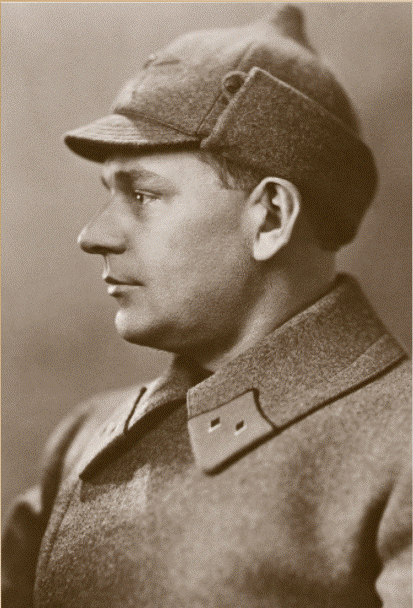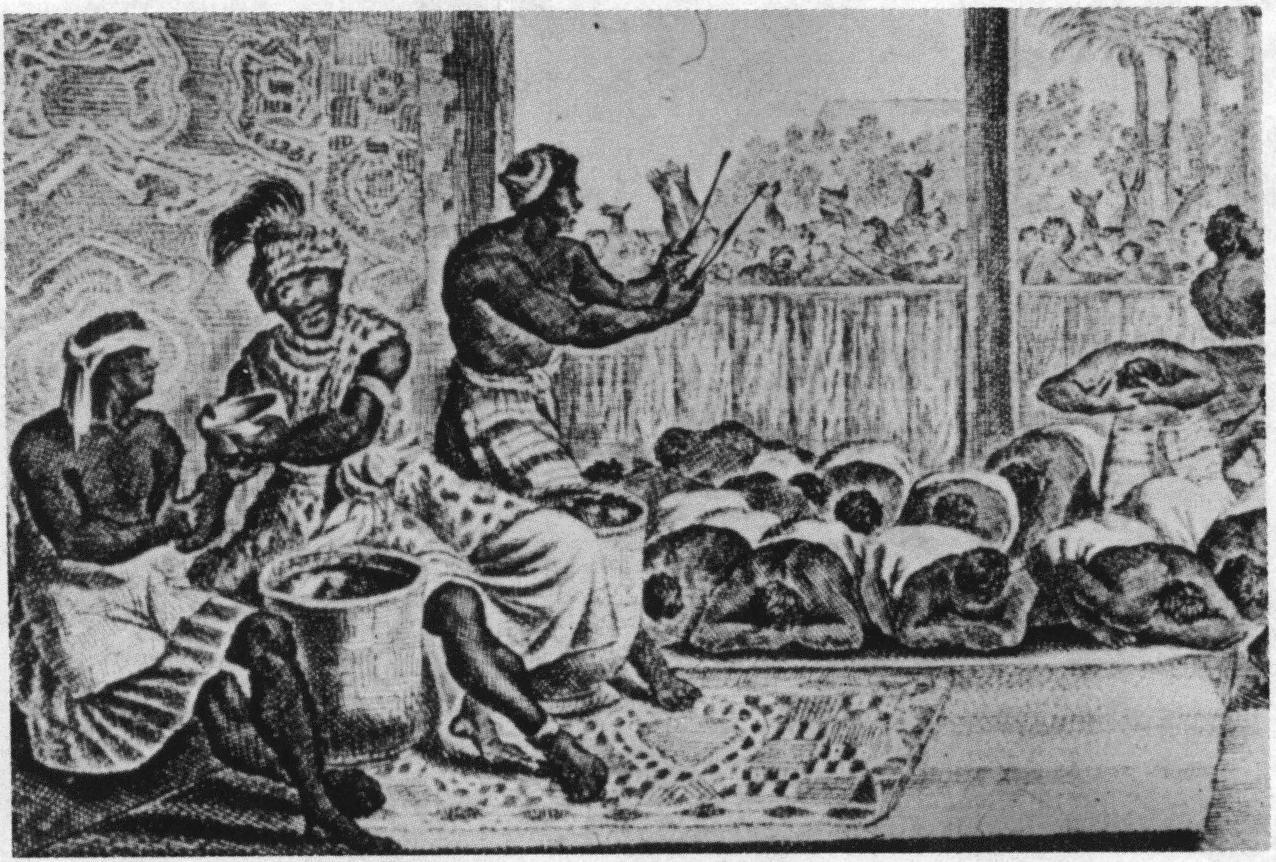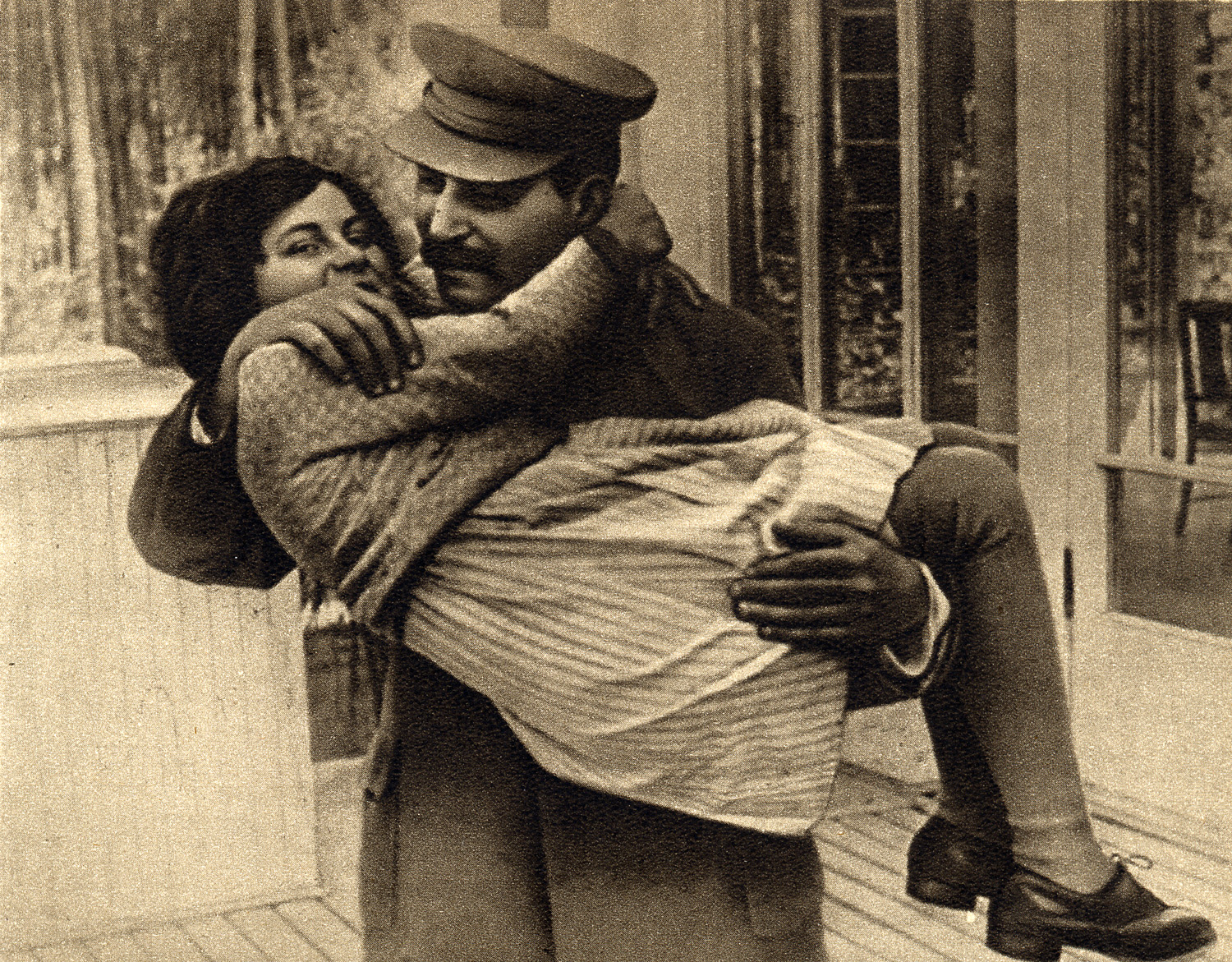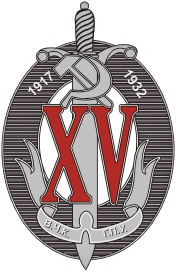|
Nikolai Vlasik
Nikolai Sidorovich Vlasik (russian: Никола́й Си́дорович Вла́сик; May 22, 1896 – June 18, 1967) was a ranking Soviet state security (NKVD-NKGB- MGB) officer, Lieutenant-General, best known as head of Joseph Stalin's personal security from 1931 to 1952. Early life Nikolai Vlasik was born to a poor peasant family in the village of Bobynichi in the Slonimsky Uyezd of the Grodno Governorate (the present-day Hrodna Voblast in Belarus) of the Russian Empire on 22 May 1896. Drafted into the Russian Army in March 1915, he earned the Cross of St. George during World War I, and by the time of the October Revolution in November 1917 had the rank of corporal. In November 1917 he began serving in the Moscow militia. In September 1919 he transferred to the Cheka. By January 1926 he had become the senior representative of the Operative branch of OGPU. Furthermore, Vlasik held supervising posts in the operations section, which included the protection of the ... [...More Info...] [...Related Items...] OR: [Wikipedia] [Google] [Baidu] |
Slonimsky Uyezd
Slonimsky Uyezd (''Слонимский уезд'') was one of the nine subdivisions of the Grodno Governorate of the Russian Empire. It was situated in the northeastern part of the governorate. Its administrative centre was Slonim. Demographics At the time of the Russian Empire Census of 1897, Slonimsky Uyezd had a population of 226,274. Of these, 80.7% spoke Belarusian, 15.2% Yiddish, 2.1% Russian, 1.6% Polish, 0.1% Lithuanian, 0.1% Ukrainian, 0.1% Tatar and 0.1% German German(s) may refer to: * Germany (of or related to) **Germania (historical use) * Germans, citizens of Germany, people of German ancestry, or native speakers of the German language ** For citizens of Germany, see also German nationality law **Ger ... as their native language. Демоскоп Weekly - Приложение. Справочник статистических пок� ... [...More Info...] [...Related Items...] OR: [Wikipedia] [Google] [Baidu] |
Joseph Stalin
Joseph Vissarionovich Stalin (born Ioseb Besarionis dze Jughashvili; – 5 March 1953) was a Georgian revolutionary and Soviet political leader who led the Soviet Union from 1924 until his death in 1953. He held power as General Secretary of the Communist Party of the Soviet Union (1922–1952) and Chairman of the Council of Ministers of the Soviet Union (1941–1953). Initially governing the country as part of a collective leadership, he consolidated power to become a dictator by the 1930s. Ideologically adhering to the Leninist interpretation of Marxism, he formalised these ideas as Marxism–Leninism, while his own policies are called Stalinism. Born to a poor family in Gori in the Russian Empire (now Georgia), Stalin attended the Tbilisi Spiritual Seminary before joining the Marxist Russian Social Democratic Labour Party. He edited the party's newspaper, ''Pravda'', and raised funds for Vladimir Lenin's Bolshevik faction via robberies, kidnappings and protection ... [...More Info...] [...Related Items...] OR: [Wikipedia] [Google] [Baidu] |
Grand Kremlin Palace
The Grand Kremlin Palace (russian: Большой Кремлёвский дворец, Bolshoy Kremlyovskiy dvorets) is a building in the Moscow Kremlin. For much of the 19th century, it served as the official residence of the Russian emperor in Moscow. Designed by a team of architects under the management of Konstantin Thon (the architect of the Kremlin Armoury and the Cathedral of Christ the Saviour), the palace was intended to emphasise the greatness of Russian autocracy. As of 2024, the Grand Kremlin Palace serves as the official working residence of the president of Russia; it also houses a museum. History The Grand Kremlin Palace was formerly the tsar's Moscow residence. It was built from 1837-1849 on the site of the estate of the Grand Princes, which had been established in the 14th century on Borovitsky Hill;_its_construction_involved_the_demolition_of_the_previous_Baroque_palace_on_the_site,_designed_by_Francesco_Bartolomeo_Rastrelli.html" "title="Baroque_architectu ... [...More Info...] [...Related Items...] OR: [Wikipedia] [Google] [Baidu] |
Despotism
In political science, despotism ( el, Δεσποτισμός, despotismós) is a form of government in which a single entity rules with absolute power. Normally, that entity is an individual, the despot (as in an autocracy), but societies which limit respect and power to specific groups have also been called despotic. Colloquially, the word ''despot'' applies pejoratively to those who use their power and authority to oppress their populace or subordinates. More specifically, the term often applies to a head of state or government. In this sense, it is similar to the pejorative connotations that are associated with the terms ''tyrant'' and ''dictator''. ''Despot'' has also been a royal title assumed by various leaders historically. Etymology The root ''despot'' comes from the Greek word ''despotes'', which means "one with power." In ancient Greek usage, a ''despótès'' was technically a master who ruled in a household over those who were slaves or servants by nature. The ter ... [...More Info...] [...Related Items...] OR: [Wikipedia] [Google] [Baidu] |
Svetlana Allilueva
Svetlana Iosifovna Alliluyeva, born Stalina (); ka, სვეტლანა იოსების ასული ალილუევა () (28 February 1926 – 22 November 2011), later known as Lana Peters, was the youngest child and only daughter of Soviet leader Joseph Stalin and his second wife Nadezhda Alliluyeva. In 1967, she became an international sensation when she defected to the United States and, in 1978, became a naturalized citizen. From 1984 to 1986, she briefly returned to the Soviet Union and had her Soviet citizenship reinstated. She was Stalin's last surviving child. Early life Svetlana Stalina was born on 28 February 1926. As her mother was interested in pursuing a professional career, Alexandra Bychokova was hired as a nanny to look after Alliluyeva and her older brother Vasily (born 1921). Alliluyeva and Bychokova became quite close, and remained friends for 30 years, until Bychokova died in 1956. On 9 November 1932, Alliluyeva's mother shot herse ... [...More Info...] [...Related Items...] OR: [Wikipedia] [Google] [Baidu] |
Nadezhda Alliluyeva-Stalina
Nadezhda Sergeyevna Alliluyeva (russian: link=no, Надежда Сергеевна Аллилуева; – 9 November 1932) was the second wife of Joseph Stalin. She was born in Baku to a friend of Stalin, a fellow revolutionary, and was raised in Saint Petersburg. Having known Stalin from a young age, she married him when she was 18, and they had two children. Alliluyeva worked as a secretary for Bolshevik leaders, including Vladimir Lenin and Stalin, before enrolling at the Industrial Academy in Moscow to study synthetic fibres and become an engineer. She had health issues, which had an adverse impact on her relationship with Stalin. She also suspected he was unfaithful, which led to frequent arguments with him. On several occasions, Alliluyeva reportedly contemplated leaving Stalin, and after an argument, she fatally shot herself early in the morning of 9 November 1932. Early life Background Alliluyeva's father, Sergei Alliluyev (1866–1945), was from a peasant family in ... [...More Info...] [...Related Items...] OR: [Wikipedia] [Google] [Baidu] |
Moscow Kremlin
The Kremlin ( rus, Московский Кремль, r=Moskovskiy Kreml', p=ˈmɐˈskofskʲɪj krʲemlʲ, t=Moscow Kremlin) is a fortified complex in the center of Moscow founded by the Rurik dynasty. It is the best known of the kremlins (Russian citadels), and includes five palaces, four cathedrals, and the enclosing Kremlin Wall with Kremlin towers. In addition, within this complex is the Grand Kremlin Palace that was formerly the Tsar's Moscow residence. The complex now serves as the official residence of the President of the Russian Federation and as a museum with almost 3 million visitors in 2017. The Kremlin overlooks the Moskva River to the south, Saint Basil's Cathedral and Red Square to the east, and the Alexander Garden to the west. The name "''Kremlin''" means "fortress inside a city", and is often also used metonymically to refer to the government of the Russian Federation. It previously referred to the government of the Soviet Union (1922–1991) and its highest ... [...More Info...] [...Related Items...] OR: [Wikipedia] [Google] [Baidu] |
OGPU
The Joint State Political Directorate (OGPU; russian: Объединённое государственное политическое управление) was the intelligence and state security service and secret police of the Soviet Union from 1923 to 1934. The OGPU was formed from the State Political Directorate of the Russian Soviet Federative Socialist Republic one year after the founding of the Soviet Union and responsible to the Council of People's Commissars. The agency operated inside and outside the Soviet Union, persecuting political criminals and opponents of the Bolsheviks such as White émigrés, Soviet dissidents, and anti-communists. The OGPU was based in the Lubyanka Building in Moscow and headed by Felix Dzerzhinsky until his death in 1926 and then Vyacheslav Menzhinsky until it was reincorporated as the Main Directorate of State Security (GUGB) of the NKVD in 1934. History Founding Following the formation of the Soviet Union in December 1922, the rulin ... [...More Info...] [...Related Items...] OR: [Wikipedia] [Google] [Baidu] |
Cheka
The All-Russian Extraordinary Commission ( rus, Всероссийская чрезвычайная комиссия, r=Vserossiyskaya chrezvychaynaya komissiya, p=fsʲɪrɐˈsʲijskəjə tɕrʲɪzvɨˈtɕæjnəjə kɐˈmʲisʲɪjə), abbreviated as VChK ( rus, ВЧК, p=vɛ tɕe ˈka), and commonly known as Cheka ( rus, Чека, p=tɕɪˈka; from the initialism russian: ЧК, ChK, label=none), was the first of a succession of Soviet secret-police organizations. Established on December 5 (Old Style) 1917 by the Sovnarkom, it came under the leadership of Felix Dzerzhinsky, a Polish aristocrat-turned-Bolshevik. By late 1918, hundreds of Cheka committees had sprung up in the RSFSR at the oblast, guberniya, raion, uyezd, and volost levels. Ostensibly set up to protect the revolution from reactionary forces, i.e., "class enemies" such as the bourgeoisie and members of the clergy, it soon became the repression tool against all political opponents of the communist regime. At the dir ... [...More Info...] [...Related Items...] OR: [Wikipedia] [Google] [Baidu] |
Corporal
Corporal is a military rank in use in some form by many militaries and by some police forces or other uniformed organizations. The word is derived from the medieval Italian phrase ("head of a body"). The rank is usually the lowest ranking non-commissioned officer. In some militaries, the rank of corporal nominally corresponds to commanding a section or squad of soldiers. By country Argentina NCOs in the Argentine Armed Forces are divided into junior and senior NCOs, with three and four ranks, respectively. The three junior ranks are called "corporal" (cabo) in both the Navy and the Air Force, while in the Army the third rank is called "sergeant" (sargento). National Gendarmerie and Coast Guard junior NCOs ranks are similar to those in the Army and Navy, respectively. Australia Corporal is the second lowest of the non-commissioned officer ranks in the Australian Army, falling between lance-corporal and sergeant. A corporal is usually appointed as a section comman ... [...More Info...] [...Related Items...] OR: [Wikipedia] [Google] [Baidu] |
October Revolution
The October Revolution,. officially known as the Great October Socialist Revolution. in the Soviet Union, also known as the Bolshevik Revolution, was a revolution in Russia led by the Bolshevik Party of Vladimir Lenin that was a key moment in the larger Russian Revolution of 1917–1923. It was the second revolutionary change of government in Russia in 1917. It took place through an armed insurrection in Petrograd (now Saint Petersburg) on . It was the precipitating event of the Russian Civil War. The October Revolution followed and capitalized on the February Revolution earlier that year, which had overthrown the Tsarist autocracy, resulting in a liberal provisional government. The provisional government had taken power after being proclaimed by Grand Duke Michael, Tsar Nicholas II's younger brother, who declined to take power after the Tsar stepped down. During this time, urban workers began to organize into councils (soviets) wherein revolutionaries criticized the pro ... [...More Info...] [...Related Items...] OR: [Wikipedia] [Google] [Baidu] |
World War I
World War I (28 July 1914 11 November 1918), often abbreviated as WWI, was one of the deadliest global conflicts in history. Belligerents included much of Europe, the Russian Empire, the United States, and the Ottoman Empire, with fighting occurring throughout Europe, the Middle East, Africa, the Pacific, and parts of Asia. An estimated 9 million soldiers were killed in combat, plus another 23 million wounded, while 5 million civilians died as a result of military action, hunger, and disease. Millions more died in genocides within the Ottoman Empire and in the 1918 influenza pandemic, which was exacerbated by the movement of combatants during the war. Prior to 1914, the European great powers were divided between the Triple Entente (comprising France, Russia, and Britain) and the Triple Alliance (containing Germany, Austria-Hungary, and Italy). Tensions in the Balkans came to a head on 28 June 1914, following the assassination of Archduke Franz Ferdin ... [...More Info...] [...Related Items...] OR: [Wikipedia] [Google] [Baidu] |





(b).jpg)



